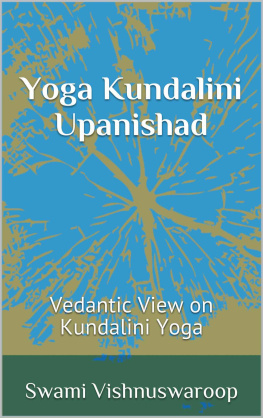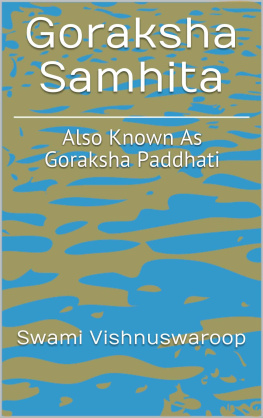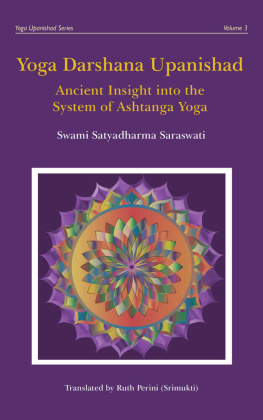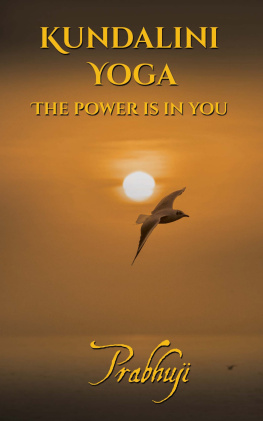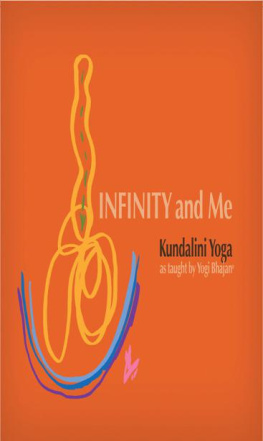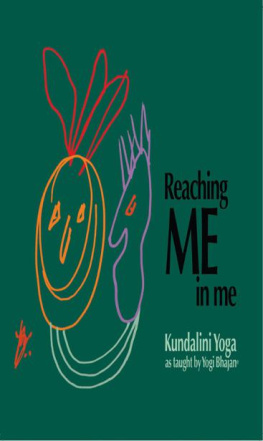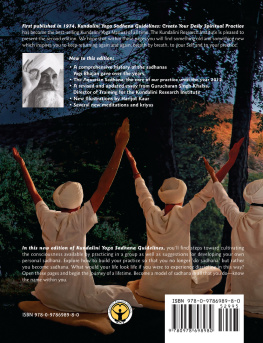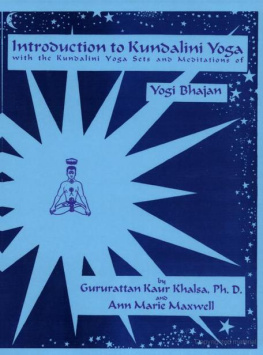Swami Vishnuswaroop - Yoga Kundalini Upanishad: Vedantic View on Kundalini Yoga
Here you can read online Swami Vishnuswaroop - Yoga Kundalini Upanishad: Vedantic View on Kundalini Yoga full text of the book (entire story) in english for free. Download pdf and epub, get meaning, cover and reviews about this ebook. year: 2015, publisher: Divine Yoga Institute, Kathmandu, Nepal, genre: Religion. Description of the work, (preface) as well as reviews are available. Best literature library LitArk.com created for fans of good reading and offers a wide selection of genres:
Romance novel
Science fiction
Adventure
Detective
Science
History
Home and family
Prose
Art
Politics
Computer
Non-fiction
Religion
Business
Children
Humor
Choose a favorite category and find really read worthwhile books. Enjoy immersion in the world of imagination, feel the emotions of the characters or learn something new for yourself, make an fascinating discovery.
- Book:Yoga Kundalini Upanishad: Vedantic View on Kundalini Yoga
- Author:
- Publisher:Divine Yoga Institute, Kathmandu, Nepal
- Genre:
- Year:2015
- Rating:3 / 5
- Favourites:Add to favourites
- Your mark:
- 60
- 1
- 2
- 3
- 4
- 5
Yoga Kundalini Upanishad: Vedantic View on Kundalini Yoga: summary, description and annotation
We offer to read an annotation, description, summary or preface (depends on what the author of the book "Yoga Kundalini Upanishad: Vedantic View on Kundalini Yoga" wrote himself). If you haven't found the necessary information about the book — write in the comments, we will try to find it.
Yoga Kundalini Upanishad: Vedantic View on Kundalini Yoga — read online for free the complete book (whole text) full work
Below is the text of the book, divided by pages. System saving the place of the last page read, allows you to conveniently read the book "Yoga Kundalini Upanishad: Vedantic View on Kundalini Yoga" online for free, without having to search again every time where you left off. Put a bookmark, and you can go to the page where you finished reading at any time.
Font size:
Interval:
Bookmark:
Yoga Kundalini Upanishad
Belonging to Krishna Yajurveda
Vedantic View on Kundalini Yoga
(English Translation of Sanskrit Text
with Roman Transliteration)
Translated into English by
Swami Vishnuswaroop
ALSO BY THE AUTHOR
Yoga Darshana Upanishad (in English)
Minor Yoga Upanishads (in English)
Hatha Yoga Pradipoka (in English)
Yogatattva Upanishad (in English)
Two Yoga Samhitas (in English)
Triyoga Upanishad (in English)
Gheranda Samhita (in English)
Goraksha Samhita (in English)
Surya Namskara (in Nepali)
Shiva Samhita (in English)
Shiva Samhita (in Nepali)
Durga Strotram (in Nepali)
Vagalamukhi Stotram (in Nepali)
Amogha Shivakavacham (in Nepali)
Copyright 2017 Swami Vishnuswaroop
All rights reserved.
Published by
Divine Yoga Institute
Kathmandu, Nepal
Tasmai Shri Gurave Namah!
To My Guru Swami Satyananda Saraswati,
Founder of Bihar School of Yoga,
Munger, India
F irst of all, I would like to express my heartfelt salutations to Adinatha (the Primordial Master) and my Guru Swami Satyananda Saraswati for their inspiration and guidance I have received for my work. I realize that my unwavering faith and belief in God and Guru is a motivational gift for me in completing this work. I could never have done it without their blessings.
I am always thankful to Ms. Bhawani Uprety for her untiring support she has provided me during the preparation of various classical texts on yoga. My many thanks go to her forever.
May God and Guru inspire us to tread the path of yoga in order to achieve the ultimate goal of human life!
- Swami Vishnuswaroop
T his Upaniad concerning Kualin Yoga belongs to Krina Yajurveda . There are three chapters in it. In the first chapter, the two causes of citta vtti , the three methods of controlling prna moderation in diet, sana and akti clini mudr are described. Then sarasvati clana , types of prnyma sryabhedi , ujjyi , shtali , bhastrik , etc., three bandhas moola bandha , uddiyna bandha and jlandhara bandha , obstacles in yoga and protection from them, awakening of kualin through yoga practice, penetration of three granthis Brahmagranthi , Viugranthi and Rudragranthi , Kualin entering sahasrra cakra (thousand petalled lotus), dissolution of prna , etc. into iva , realization of Self everywhere during samdhi and subjects like Samdhi Yoga , etc. are described in detail.
The second chapter begins with the lucid explanation of khecari mudr . The features of khecari , its results, perfection of khecari by mantra japa , sequence of khecari practice, etc., are described elaborately.
In the beginning of the third chapter the khecari melana mantra for khecari siddhi is described specifically. The vision of a sdhaka during his sdhan is described by giving examples of new moon, first lunar date and full moon. Then attaining perfection for the union with macrocosm through prnyma , impossibility of Self-realization without practice, knowledge of the Brahman through the discourse of a Sadguru , manifestation of Brahma in the form of vk , vtti and viva , etc., the nature of Parabrahma and at the end, means to attain Brahma dhyna , jvanmukti and videhamukti , etc., topics are explained.
Thus, the major subjects of yoga are presented in this Upaniad , which makes it unique and complete.
It should be noted that the original Sanskrit Text is in Devanagari along with its Roman transliteration. All the Sanskrit words/phrases that appear in the English translation are given in the transliterated Roman alphabets.
It is hoped that this book will be helpful to all who are interested to understand the vedantic view on Kualin Yoga .
Publisher
om sahanvavatu / saha nau bhunaktu /
saha virya karavvahai /
tejasvinvadhitamastu m vidvivahai //
om nti om nti om nti //
O M! May He protect both of us (the teacher and disciple) together. May He nourish both of us together. May both of us get strength and power together. May our knowledge (shared between us) be lustrous. May there not be animosity between us.
OM! May the three types of miseries be peaceful.
Vsan and Prna Activate the Mind
hetudvaya hi cittasya vsan ca samraa /
tayorvinaa ekasminstaddvvapi vinayata // //
There are certainly two causes (of the unsteady state) of citta (the mind). They are vsan (deep rooted desires/cravings) and samira or prna (the life force). If one of them is destroyed, then both of them are annihilated. 1.
Three Ways to Control Prna
tayordau samrasya jaya kurynnara sad /
mithracsana ca akticlasttyaka // //
Of these two, first of all, a person should gain victory over samira or prna . There are three ways to achieve it. They are mithra (moderation in diet), practice of sana and the third one, akticlin mudr . -2.
Mithra and sana
ete lakaa vakye uu gautama sdaram /
susnigdhamadhurhracaturthavivarjita // //
bhujyate ivasamprtyai mithra sa ucyate
sana dvividha prokta padma vajrsana tath // //
O Gautama ! I shall explain the characteristic of these. Listen to it with due respect (attentively). One should take sweet and nutritious food (fill half of his stomach with food and one quarter of it with water) and leave one fourth of his stomach empty. This way of eating with due regard for iva (welfare) is called mithra (moderation in diet). Two types of sana (mainly for gaining victory over prna ) are described. They are padmsana and vajrsana. -3-4.
Padmsana and Vajrsana
rvorupari ceddhatte ubhe pdatale yath /
padmsana bhavedetatsarvappapraanam // //
Placing each foot on the opposite thigh with its sole facing upward is the padmsana which is the destroyer of all sins. -5.
vmghrimlakaddho hyanya tadupari kipet /
samagrvaira kyo vajrsanamitritam // //
Placing one heel below the mlakanda (perineum or the root of the genital organ) and the other over it and sitting with the neck, head and body upright is called the vajrsana . -6.
akticlana
kualyeva bhavecchaktist tu sanclayedbudha /
svasthndbhruvormadhya akticlanamucyate // //
It is said that the main akti is kualin . A wise yogi should take it up from svasthna (its place i.e. mldhra ) to bhrumadhya (the middle of the eyebrows). This is called akticlana . -7.
Two Means of Awakening Kualin
tatsdhane dvaya mukhya sarasvatystu clanam /
prarodhamathbhysdjv kualin bhavet // //
There are chiefly two means of awakening kualin . They are sarasvati clana and prarodha (the restraint of prna ). Through the practice of the restraint of prna, the coiled kualin becomes straight. -8.
Sarasvati Clana
tayordhau sarasvatyclana kathaymi te /
arundhatyeva kathit purvidbhi sarasvat // //
First of all, I shall explain you sarasvati clana . Sarasvati was also called arundhati by the wise of the yore. -9.
yasy sanclanenaiva svaya calati kual /
iy vahati pre baddhv padmsana ddham // //
When prna is flowing through id (left nostril), one should assume padmsana firmly and should practice sarasvati clana properly. Through this practice the kualin is awakened itself. -10.
Note: Sarasvati clana is the arousal/stimulation of sarasvati ndi.
dvdaguladairghya ca ambara caturagulam /
vistrya tena tann veayitv tata sudh // //
Then the wise yogi should wrap the ndi (at the place of kanda ) with a piece of cloth which is twelve-inch long and four-inch wide. -11.
aguhatarjanbhy tu hastbhy dhrayeddham /
svaakty clayedvme dakiena puna puna // //
And then he should hold firmly both nostrils with the forefingers and thumbs should first exhale and inhale again and again through right nostril and then through the left according to his capacity. -12.
Next pageFont size:
Interval:
Bookmark:
Similar books «Yoga Kundalini Upanishad: Vedantic View on Kundalini Yoga»
Look at similar books to Yoga Kundalini Upanishad: Vedantic View on Kundalini Yoga. We have selected literature similar in name and meaning in the hope of providing readers with more options to find new, interesting, not yet read works.
Discussion, reviews of the book Yoga Kundalini Upanishad: Vedantic View on Kundalini Yoga and just readers' own opinions. Leave your comments, write what you think about the work, its meaning or the main characters. Specify what exactly you liked and what you didn't like, and why you think so.

